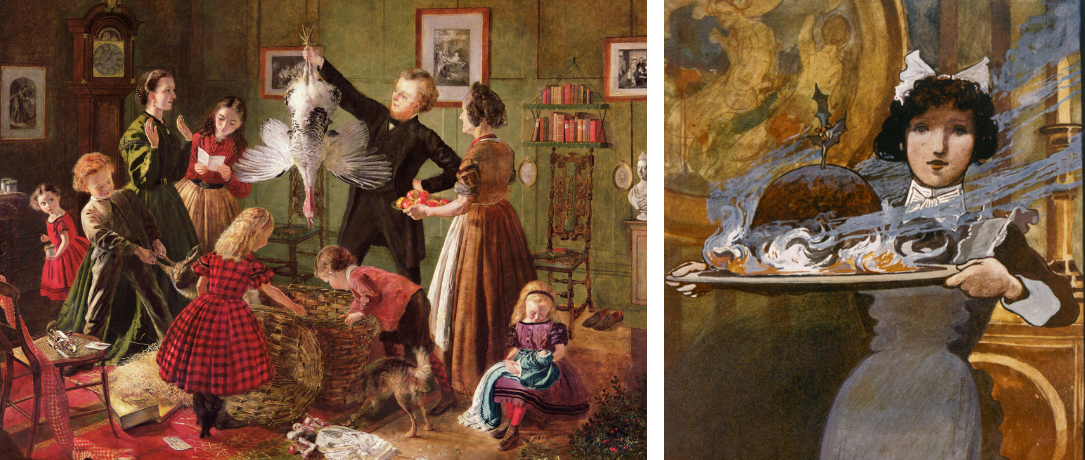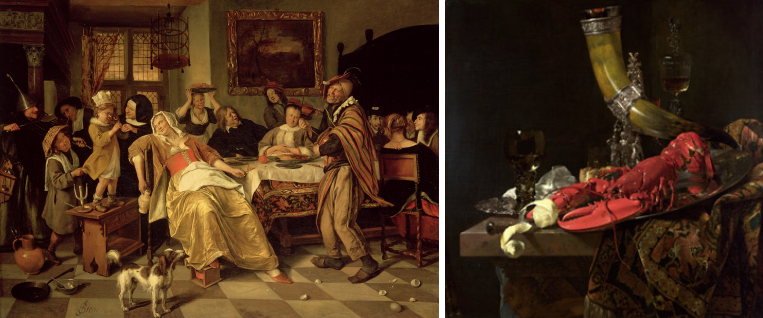
Art of the Feast
It’s time to let out your belt as the seasonal holiday period is upon us. As well as a religious occasion, Christmas is a time to sit around the table with loved ones, enjoy a plentiful feast and be thankful for our blessings. In honour of the holiday, we explore the enduring theme of food and celebration in art as well as the history of our traditional festive meal.
The Bacchanal: Ancient Rome to the Renaissance
In ancient times Roman feasts were legendary. Frescoes on palace walls in Pompeii have been known to depict the act of vomiting after eating large quantities of food in order to continue the revelry. In the Renaissance, the Bacchanal (the feast of Silenius aka Bacchus, the God of Wine) was a common subject for painters such as Poussin, Titian, Velazquez and Rubens.

Left: Triumph of Bacchus, 1628 (oil on canvas) by Diego Velazquez; Prado, Madrid.
Right: Ministrant Carrying a Tray of Food with Silenus Playing a Lyre and a Young Satyr Playing a Syrinx, North Wall, Oecus 5, 60-50 BC (fresco), Villa dei Misteri, Pompeii
High Society in the Middle Ages
Sandwiched in between antiquity and the Renaissance, came the more austere period of the Middle Ages. The daily life of Medieval courtiers and royalty was chronicled in manuscripts called Books of Hours. These books typically contained scenes from the life of the person who commissioned the book along with prayers and church and lunar calendars. One of the most important of these manuscripts is the 15th century Tres Riches Heures du Duc de Berry, which contains elaborate illustrations such as the detail of the Duke’s household exhanging gifts over a meal (see below).

Ms 65/1284 f.1v January: Banquet Scene, from the ‘Tres Riches Heures du Duc de Berry’ (vellum) , Limbourg Brothers (fl.1400-1416) / Musee Conde, Chantilly, France
Still Life & Merry Company in the Dutch Golden Age
17th century Dutch painters were masters of realism, but ingrained in every painting is an allegorical view of nature that conveyed moralizing messages to its contemporary viewer. These still life paintings look inviting enough to eat, but nestled within are subtle messages about the transience of life: partially peeled fruit, a toppled glass, a half-eaten pie. Artists such as Willem Claesz Heda, Pieter Claesz and Willem Kalf were masters of this genre. Dutch painters were also wonderful at painting scenes of everyday life which have come to be known as merry companies. They involve a group of people enjoying food, drink and music or games in a private house or tavern. Like the still life paintings the mundane subject matter always contained a hidden moral subtext. Frans Hals, Jan Steen and Gerrit van Honthorst are artists who excelled in this genre at the height of the Dutch Golden Age, but it could be said that Pieter Bruegel is the father of the merry company.
Quiet Celebrations of Beauty
The Impressionists and Post-Impressionists also painted everyday subject matter, but without the Dutch penchant for moral subtext. No longer was a still life painting a beautiful shell for a deeper message. Painters such as Cezanne and Pierre Bonnard saw beauty, light and color in simple peaches, apples and table settings. Their paintings are quiet celebrations, but celebrations nonetheless.
The Christmas Feast
Christmas dinner is the primary meal traditionally eaten on Christmas Eve or Christmas Day where the whole family get to sit together, forget their troubles and gorge to their heart’s content.
Christmas feasts have traditionally been luxurious and abundant. King John of England, in the year 1213, ordered about 3,000 capons, 1,000 salted eels, 400 hogs, 100 pounds of almonds and 24 casks of wine. In England, the evolution of the main course into turkey did not take place until the French Jesuits imported the turkey in the 1700s. At first, in Medieval England, the main course was either a peacock, swan or a boar – for the rich at least.

Left: The Christmas Hamper/ Robert Braithwaite Martineau
Right: Bringing in the plum pudding/ English School
The Christmas pudding is steeped in history and tradition – and alcohol
Beef and mutton were the initial main ingredients but by 1595 the Elizabethans had come to their culinary senses ditching the meat, adding beer or spirits and renaming it plum pudding. By 1650 it had become the customary Christmas dessert, but soon after the Puritans banned it for being indulgent and pagan in origin. King George I re-established it as part of the Christmas meal and by Victorian times Christmas puddings had become pretty similar to the alcohol infused cannon ball of rich dried fruit that’s eaten today.
Find out more:
See more images of Christmas feasts
Read about other weird and wonderful Christmas beliefs
All images in this article are sourced from www.bridgemanimages.com.
Contact the Bridgeman sales team (uksales@bridgemanimages.com) for more information regarding licensing, reproduction and copyright issues.
Save
Save
Save


